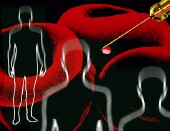
MONDAY, March 21 (HealthDay News) — The American Heart Association is urging doctors to treat the worst cases of potentially life-threatening blood clots that form in the legs’ deep veins more aggressively.
These clots can break loose and travel to the lungs, causing a pulmonary embolism, which can be fatal.
Each year in the United States more than 250,000 people are hospitalized for deep vein thrombosis, whose symptoms include sudden swelling and unusual pain, tenderness and warmth in a leg. Until now, there has been little guidance on how best to treat the most serious cases of the emergency condition, according to the heart association.
For patients, the new guidelines should make a difference in outcomes, said co-author Dr. M. Sean McMurtry, an assistant professor of medicine in the division of cardiology at the University of Alberta in Edmonton, Canada. “Ideally, it will lead to better care,” he said. “While most patients don’t die from pulmonary embolism, when you start talking massive pulmonary embolism, it can have a significant mortality rate.”
“It would be ideal if we could help practitioners identify people whose lives could be saved by these more aggressive interventions,” McMurtry said.
Noting that many patients with the most severe blood clots and related complications need more than blood thinners, the heart association is recommending aggressive treatment with clot-busting drugs. In addition, the group recommends inserting catheters in blood vessels to open them up.
For certain patients, the heart association also recommends surgery to remove clots and the insertion of filters in the vein to prevent new clots from traveling to the lungs.
Dr. Ralph Sacco, president of the American Heart Association and chairman of neurology at the University of Miami Miller School of Medicine, agreed that “there are still more people out there with deep vein thrombosis that are undertreated. The good news is that there are many effective treatments.”
The new guidelines from the American Heart Association are published in the March 21 online edition of Circulation.
McMurtry explained that these guidelines “are about what to do if somebody’s got massive pulmonary embolism or very large clots high up in the leg,” or a condition that people with pulmonary embolisms can develop called chronic thromboembolic pulmonary hypertension (high blood pressure in the lungs).
Anyone can develop deep vein thrombosis, McMurtry noted. Typically, deep vein thrombosis and pulmonary embolism occur in patients who are hospitalized and are confined to bed for extended periods after a trauma or surgery or other medical problems like cancer, he said. Some people have also developed DVT on long international plane flights.
Deep vein thrombosis and pulmonary embolism are as common as heart valve disease, although the severe forms of these problems — highlighted in the guidelines — are less common, he added.
The guidelines also include recommendations for children.
“Practitioners are aware that these invasive therapies are out there, but often have trouble identifying who might benefit from them,” McMurtry said. “This document will help the practitioner identify folks who might be candidates.”
Commenting on the new guidelines, Dr. Gregg C. Fonarow, a professor of cardiology at the University of California, Los Angeles, said that earlier guidelines have already addressed the prevention and treatment of uncomplicated deep vein thrombosis, but the new guidelines address the more complicated cases.
Deep vein thrombosis is common and results in substantial morbidity, mortality and health care costs, and it is one of the most common preventable causes of death in the hospital, Fonarow said.
“An estimated 10 percent of in-hospital deaths are secondary to pulmonary embolism,” he said.
“Application of these guidelines into clinical practice should help to improve outcomes for patients with the most serious forms of deep vein thrombosis,” he added.
More information
For more on deep vein thrombosis, visit the U.S. National Heart, Lung, and Blood Institute.

